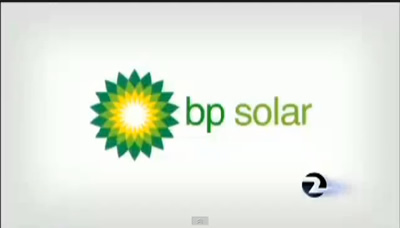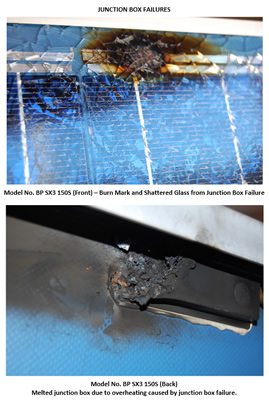|
Solar module manufacturer BP Solar - the "green" branch of energy giant British Petroleum (the same folks who brought you the Deepwater Horizon disaster in the Gulf of Mexico) - exited the solar market in 2011. But now a class-action lawsuit is alleging that BP Solar knew as early as 2005 that some of its solar modules, including ones that were widely sold in California, pose a serious risk of failure and even fires. Will BP step up and do the right thing? (For the record, Run on Sun never used BP Solar modules.)
BP does not deny that they have a potential problem. In a carefully worded 2012 Product Advisory, BP acknowledged the following:
“This product advisory is being issued to communicate a potential risk when using certain BP Solar modules in specific types of installations. Testing has shown there is a limited risk of cable to busbar disconnection in the junction box that, in rare cases, may lead to a thermal event in certain applications of the products referenced below. A thermal event, depending upon the severity, can cause secondary damage to surrounding materials that are not fire resistant.”
While BP's advisory uses the overly lawyered phrase, "thermal event" to describe what can happen, others use less measured language.

Click to watch video
|
A report on Bay Area television station KTVU/Fox 2 speaks of consumer complaints about solar modules with a bevy of problems including "burning up, shattering and putting homes in danger."
BP is not the only entity to "lawyer-up." The two-person law firm of Birka-White is challenging BP in a class action lawsuit (see the complaint here) that harkens back to David taking on Goliath.
|
Birka-White, which had previously sued Suntech over problems with solar roofing tiles, a problem we have documented in our blog, alleges in their suit that a defect in the junction box on the affected BP solar modules causes them to fail, "resulting in a loss of electric current and serious safety risks, including the risk of fire." Despite that risk, the complaint alleges that BP continued to sell the defective modules until 2010, even though BP knew of the defects "since at least 2005."
More specifically, the complaint alleges that:
|
17. The connection between Solar Panels is made at a junction box attached to each Solar Panel. A defect in the junction box and the solder joints between the connecting cables causes the solder joint to overheat.
|
|
18. When the solder joint overheats, the connection between the Solar Panels breaks. This break in the circuit results in an arc of an electrical current which generates heat between 2000-3000 degrees Fahrenheit.
19. The heat caused by this failure melts the junction box, burns the cables and the Solar Panel and shatters the glass cover of the Solar Panel. Attached hereto as Exhibit D are photographs of BP Solar Panel junction box failures. If there is flammable material near the heat source, such a [sic] dry leaves, the junction box failure creates a high risk of fire. Fires caused by junction box failures have already occurred and there is a substantial risk that they will occur in the future.
20. Because of the defect in the junction box, all Solar Panels relevant to this litigation have failed or will fail before the end of their expected useful life.
|

|
The photos above are taken from Exhibit D and show the sort of "thermal event" that the affected homeowners (the potential members of the class to be certified as part of the litigation) could experience.
Faced with such compelling evidence of product defects, what has BP's response been? You guessed it - to hide behind their limited warranty and to offer consumers a financial remedy that falls far short of making them whole.
To be sure, any product can have a defect, and it is by no means uncommon for a corporation to seek shelter from liability for such defects by pointing to limiting language in its product warranties. Yet BP, which had a net profit in 2013 of $13.4 billion, would certainly seem to be in a position to compensate the innocent victims of its product defects more fully. Of course, having halted solar operations altogether, BP has no ongoing vested interest in avoiding the black eye that its stonewalling will inevitably create for the entire solar industry. Indeed, how will other solar module manufacturers respond to BP's failure and the ensuing litigation? Strong statements from industry leaders affirming their commitment to address problems arising from product defects promptly, and to go beyond the fine print of their limited warranties, could go a long way to restoring consumer confidence damaged by these BP revelations.
Scope of the Problem in California
We decided to take a look into the CSI data to get a sense of how big an issue this might be in California. BP's product advisory asserts that only certain module models, and only those manufactured from March 1, 2005 to October 31, 2006 have the defect that can lead to "thermal events." The complaint, however, disputes that limitation, alleging that, "the risk of junction box failure exists for all Solar Panels - not just the limited number listed in the Product Advisory - manufactured at any time - not just the limited time frame covered by the Product Advisory."
Regardless of which position is determined to be accurate, the CSI data provides no visibility into installations prior to 2007. And while the problem may or may not affect module models beyond those listed in the Product Advisory, as far as the data is concerned, the vast number of residential installations made use of only two BP models: BP175B and BP4175B - both of which are listed on the Product Advisory. Both products appear in the data as of 2007 (which could easily include modules manufactured during the Product Advisory period) and continue into this year. The peak year for installations of the 175B module was 2010, whereas the 4175B peaked the year later, in 2011. Here is the distribution:
At a minimum, those 135 installation in 2007 would likely have used modules from the Product Advisory period, and if plaintiffs are correct, there could be as many as 1,300+ installations based on these two modules alone.
While there is no doubt that individual homeowners bear the greatest personal risk, there are more than 100 companies that installed these BP modules, potentially exposing them to liability for failures. Affected companies include major players like SolarCity, Verengo, and Sungevity, as well as dozens of much smaller companies, many of which are no longer in business. Those companies relied upon BP's representations and are also victims here.
While larger companies might have the resources (if not necessarily the inclination) to help out their customers in this situation, smaller companies with more limited resources are not in a position to foot the bill for replacement systems (the remedy being sought in the litigation). Never-the-less, they can and should offer free inspections to their affected customers. It will be far better for the solar industry if a customer learns of a potential problem from the company that installed their system than if they hear about it in the media, or worse, suffer a "thermal event" on their own roof.
As solar installers, we depend upon manufactures to produce products that are safe and reliable, and to stand behind those products when there is an issue. We cannot, sadly, control the outcome when a supposedly competent manufacturer introduces defective products and then refuses to act responsibly. We can, and must, however, take all reasonable steps available to us to mitigate the harm - to our clients and to the industry - when such unpleasant circumstances arise. |